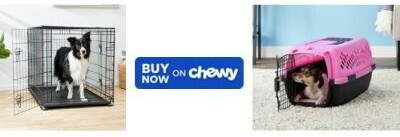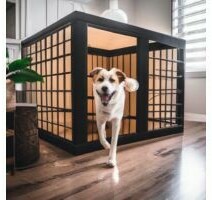
We used the crate training technique when we potty trained our Golden Retriever, Lucy. It really worked well, so I wanted to share some tips for crate training a puppy in this post. Among several other things, part of the process includes a schedule for crate training a puppy and how to go about that. I will go over that and many other things to consider, so let’s check it out!
Crate training taps into a puppy’s denning instinct, the natural drive to find a secure, snug spot to rest. This isn’t just about giving them a place to sleep; it’s about providing a personal haven where they can feel safe and at ease.
Now, what makes crate training shine? It offers a bounty of benefits. For one, it aids in housebreaking, as puppies don’t like to soil their sleeping quarters. It’s also a lifesaver when you need to transport your furry friend, which is much safer for them when riding in a vehicle, or keep them from chewing on household items while you’re away. Plus, it cultivates a self-soothing environment for times when they’re alone.
But let’s get something straight. Crate training is not about confining your buddy arbitrarily. Done properly, it respects your puppy’s comfort and limits. It will bring them peace, not stress. And as a bonus, it gives you peace of mind, knowing they’re in a secure spot when you’re not around or when you’re both calling it a night.
We will dive into crate selection and setup next, ensuring a cozy, welcoming retreat for your new puppy. It’s a key step in making crate training not just successful, but a positive experience for everyone involved.
There are many popular models to choose from:

Or if you want an upgrade:

Preparing for Crate Training: Setting Up for Success
Choosing the right crate for your puppy isn’t just about the size—it’s about comfort and security. You’re going to want a crate that’s big enough for your puppy to stand up, turn around, and lie down comfortably, but not so large that they feel insecure. The material can range from durable plastic to wire—each has its advantages depending on the situation. Wire crates tend to be more open and airy, great for warm climates, while plastic crates can feel cozier and are approved for airline travel, if that’s on your radar.
Now, where you put the crate is as important as the crate itself. Think of it as your puppy’s personal bedroom. So choose a spot that’s quiet enough to offer sanctuary, but close enough to the family areas so they don’t feel isolated. Avoid placing the crate in direct sunlight, drafty doorways, or busy walkways where your pup might be disturbed.
The crate should be a haven, not a cell. To make it welcoming, toss in a soft bed or blanket that’s easy to wash. A chew-proof tough toy can provide comfort and keep your puppy occupied. Never underestimate the power of a familiar scent either—a worn T-shirt of yours can go a long way in soothing a nervous pup.
Finally, make sure you’re equipped with the essentials before embarking on this crate training journey. You’ll need treats for positive reinforcement, a schedule to maintain routine, and a dollop of patience. Crate training can take days or weeks, depending on your puppy’s age, temperament, and past experiences, so be prepared to adjust your approach down the road.
Step-by-Step Crate Training Techniques

Introducing your new puppy to their crate requires a gentle touch. Start by leaving the door open and letting them explore on their own terms. I’m going to suggest using treats to make this a positive experience. Place them inside, near, and all around the crate to encourage a game of treasure hunt.
Once your puppy is comfortable entering the crate, it’s time to feed them their meals inside. This isn’t just about giving them food; it’s also about associating the crate with happy, calm feelings. After a few successful meals, try closing the door while they’re eating and gradually increase the time the door stays shut with each meal.
Creating a daily routine is key. Begin with short periods of crated time while you’re home, and slowly extend the duration as they become more accustomed. Ensure you’re around to reassure them. If you hear whining, wait until it stops to avoid reinforcing that crying equals release.
Not all puppies will take to the crate immediately – and that’s okay. If you encounter resistance, take a step back in the process. Use more treats, extend your patience, and never force them in. Remember, crate training is a marathon, not a sprint.
As your puppy learns to stay in the crate longer, remember to keep an eye on their limits. Young puppies need frequent bathroom breaks. Don’t expect more from them than they can biologically handle. Being patient is crucial to the process.
Maintaining Crate Training: Tips for Long-Term Success

I know this sounds like a broken record, but consistency is key in reinforcing good crate habits for your puppy. Regular feeding schedules, consistent commands, and predictable crate times help your puppy understand what to expect and feel secure.
Balancing the hours your puppy spends in the crate with plenty of playtime and exercise outside the crate is crucial. This not only keeps your puppy physically fit but also mentally stimulated, which can reduce undesirable behaviors.
Remember, the crate is meant to be a safe haven, not a punishment. Never use the crate as a time-out space when your puppy misbehaves. Doing so can create negative associations and set back your training efforts.
As your puppy matures, you’ll likely find they need less crate time. Recognize the cues that your puppy is ready for more freedom and gradually extend the periods they spend outside the crate while still maintaining crate training benefits.
Even the best crate training plans can hit some snags. If your puppy shows signs of distress or if you’re struggling to keep up with the training, don’t hesitate to consult a professional trainer. Your puppy’s well-being and your peace of mind are worth the extra support. And once again, at the risk of sounding redundant, have patience with your four legged family member.
I hope this information helps with crate training for your puppy. And as always, feel free to leave any questions or comments you may have.

